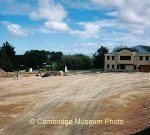Learn Ako
Fun learning experiences for school visits, classroom sessions, heritage walks and for families at home.
Cambridge Explore
Cambridge in the 1990s

1990 marked 150 years since the signing of Te Tiriti o Waitangi – The Treaty of Waitangi.
The Cambridge Electric Power Board turned 70 years old at the beginning of 1990 and by the end of the year was moving along with the Government’s Energy Reform. In April 1993, changes in electricity regulations saw Cambridge Electricity and the Te Awamutu Electric Power Board merge to form Waipa Power Ltd.
In 1991 the last Soviet Ambassador to New Zealand, as a guest of the Chamber of Commerce, visited Cambridge and was enthralled with the local Museum. In this same year we adopted $1 and $2 coins and did away with the paper notes.
Telecom replaced the state-owned Telegraph Services and Gus Wackrow’s Joinery erected the new/old octagonal telephone box on the Empire Street corner.
Empire Street also got a face lift in 1993 when a mural was painted depicting a Victorian shopping scene.
In 1993 we celebrated, along with the rest of New Zealand, one hundred years of Women’s Suffrage.
The Tree Trust and Lions erected the viewing platform and Tree Trail maps at Lake Te Koutu and started labelling the specimen trees. Voluntary organisations, including the Te Koutu Lake Improvement Society, Jaycees, the Beautifying Society, Lions and Borough and District Council Parks and Reserves staff, have continued to put many hours into the beautification of Te Koutu Domain. The ducks are still enjoying the lake and are oblivious to a name change to Te Ko Utu.
A Heritage Trail was opened in 1996, sign posting important buildings and sites to educate the people and preserve our history.
1994 Weddel Aotearoa meatworks went into receivership and local unemployment figures increased by 500. It was estimated that $12 million in wages would be lost to the local economy. Cambridge people are resilient and versatile.
The site, Aotearoa Park has been redeveloped, with the help of the Waipa District Council, into an industrial estate of 37 sites and has become very popular.
The BNZ’s storage shed was developed into a brightly coloured three storeyed building – an example of how old buildings can be recycled.
More old buildings got a new lease of life with the Oddfellows Lodge becoming a shop, part of the power board building is a restaurant, the Leamington Band Rotunda is used for art classes and the former Carnegie Library is a Visitor Information Centre.
The Cambridge Police moved from the old Defence Reserve in Victoria Street to a new station in Dick Street in 1997. The old station had been upgraded in 1990 but, after the merger with the Traffic Safety Branch in 1992, bigger premises had to come.
The Waikato/Cambridge Independent newspaper’s last issue was printed on 26 April 1995 having spread the news since 1904. The Cambridge Museum bought their archives making Cambridge’s history available for everyone.
In the mid 1990s, with a change of style in pubs and social entertainment, the Prince Albert was built on the old Tudor Theatre site. At the same time, horses and tourism came together with the opening of the Cambridge Thoroughbred Lodge and the District Council started the development of Lake Karapiro Domain.
A new Service Centre and library for the Waipa District Council was built in Wilson Street with the old library being sold for a new shopping development.
It was reported in 1987 that only five years remained for residential development in Cambridge. In 1998 the Oaklands subdivision north of Cambridge opened to provide more residential sections for the growing town. Too late for some larger family homes, which have been moved out of town to make way for three or four home units built on their quarter acre sections.
In the beginning of the 1880s the only thing Cambridge needed for progress was the Railway. At the beginning of 1999 the 3.8 km of railway line between Hautapu and Cambridge was pulled up.
Cambridge progressed through alternative routes, with the Waikato River holding its own well into the century. Road transport firms, from the days of horse and wagons, have been to the fore in Cambridge.
In 1999 the Cambridge Landfill off Bracken Street (run by the District Council) was full. A change was made in November to a privately operated Transfer Station at Aotearoa Park.
Ramifications in the soil deposits from both rubbish dumps and gasworks was brought home when it was found that the Tree Trust Nursery would have to be moved.
St John Ambulance renovated their facilities making room for another ambulance, training facilities and accommodation for staff. In August 1999, our power bills were sporting the TrustPower logo and a search was on for a new General Manager for the Waipa District.
At the end of September the Warehouse, opposite the Cambridge Museum, opened its doors for business. And strangely enough the bright red colour did not cause as much controversy as the accompanying Sandstone (grey) – which should have been Desert Sand (cream)!
At the end of November the culmination of over 40 years work saw the opening of the Cambridge Community Marae in Bracken Street. It all started back in the 1940s when the Plunket Rooms were being used as an eating place, and a restroom for Maori was suggested. By 1953 the Maori women favoured a community centre and there the focus stayed.
At midnight 31 December 1999, St Andrews Anglican church bells helped Cambridge celebrate with the rest of New Zealand, and welcomed the year 2000 with a long lusty peal.
